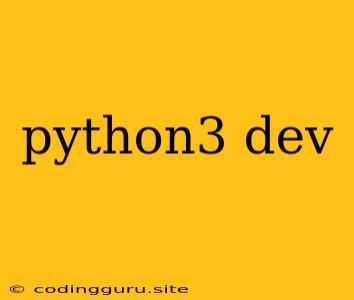Embark on Your Python3 Development Journey: A Comprehensive Guide
Are you looking to dive into the world of Python development? Python3 is the latest version of this versatile and popular programming language, offering a plethora of benefits for developers of all levels.
This guide will equip you with the essential knowledge and resources to embark on your Python3 development journey. Whether you're a complete beginner or have some coding experience, we'll cover the fundamentals and empower you to create remarkable applications.
Why Python3?
Python3 has gained widespread popularity due to its:
- Readability: Python's syntax is renowned for its simplicity and readability, making it easy to learn and understand.
- Versatility: It can be used for a wide range of tasks, including web development, data science, machine learning, scripting, and more.
- Large and active community: A vast community of Python developers provides extensive support, resources, and libraries.
- Extensive libraries: The Python Package Index (PyPI) offers a wealth of pre-built modules and libraries, saving you time and effort.
Setting Up Your Python3 Development Environment
Before you can start coding in Python3, you need to set up your development environment. Here's how:
- Download and install Python3: Visit the official Python website and download the latest version of Python3 for your operating system. Follow the installation instructions provided.
- Choose a code editor or IDE: An Integrated Development Environment (IDE) or a code editor can greatly enhance your development experience. Some popular options include:
- VS Code: A lightweight and feature-rich code editor with excellent Python support.
- PyCharm: A powerful IDE specifically designed for Python development.
- Sublime Text: A versatile code editor with a wide range of plugins and customization options.
- Install essential packages: Once you have Python3 installed, you may want to install additional packages for specific functionalities. Use the
pippackage manager to install these packages. For example:pip install numpy
Fundamentals of Python3 Programming
Let's delve into the fundamental concepts of Python3 programming:
- Variables: Variables are used to store data in your program. You can assign values to variables using the assignment operator (=).
name = "John" age = 30 - Data types: Python supports various data types, including:
- Integers: Whole numbers (e.g., 10, -5)
- Floats: Decimal numbers (e.g., 3.14, -2.5)
- Strings: Text enclosed in quotes (e.g., "Hello", 'World')
- Booleans: True or False values
- Operators: Operators are used to perform operations on data. Python provides various operators such as arithmetic operators (+, -, *, /), comparison operators (==, !=, >, <), logical operators (and, or, not), and more.
- Control flow: Control flow statements determine the order in which code is executed. Python uses keywords like
if,elif,else,for, andwhileto control program flow. - Functions: Functions are reusable blocks of code that perform specific tasks. You define functions using the
defkeyword.def greet(name): print(f"Hello, {name}!") greet("Alice") - Modules and packages: Modules are collections of Python code that can be imported into your program. Packages are collections of modules.
import math result = math.sqrt(25) print(result)
Building Your First Python3 Project
Now that you have a solid understanding of the fundamentals, let's build a simple Python3 project to solidify your learning:
Creating a "Hello World" program:
- Open your code editor or IDE.
- Create a new file named
hello_world.py. - Add the following code:
print("Hello, World!") - Save the file.
- Run the program from your terminal using the command:
You should see the output "Hello, World!" printed on your console.python hello_world.py
Resources for Continued Learning
The world of Python3 development is vast and constantly evolving. Here are some valuable resources to help you continue your learning journey:
- Official Python documentation: The official Python documentation is an invaluable resource for comprehensive information and tutorials.
- Online courses: Platforms like Coursera, Udemy, and edX offer a wide array of Python3 courses suitable for different skill levels.
- YouTube tutorials: Numerous YouTube channels provide engaging and informative Python3 tutorials for beginners and advanced learners.
- Python community forums: Engage with the active Python community on forums like Stack Overflow and Reddit to seek help, share your knowledge, and stay updated on the latest developments.
Conclusion
This comprehensive guide has provided you with a solid foundation for your Python3 development journey. By following the steps outlined, you can quickly set up your development environment, grasp the fundamentals of Python3 programming, and build your first simple project. Remember, the journey of learning Python3 is continuous, so leverage available resources, practice consistently, and embrace the ever-evolving nature of this powerful language.
